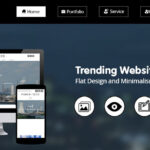
How you go about hiring a web designer can make a world of difference in maintaining the quality of your website — and essentially meeting your expectations.
If you get these right, you might even exceed those expectations. That would be great, right? So what do you need to do to get there?
To start, when planning a project that includes web design, there are some important things to consider. For starters, you want to ask the right questions — but what are the best questions to ask?
How do you approach the process of analysing different web design teams, and what criteria do you implement to guide your decision making process?
You want to amplify your chances of making the best choice for your small business website design, and that takes some work. There’s a lot at stake, too.
Obviously, you want to get it right the first time. You don’t want to be wasting time and effort going back and forth over the design.
At times, some elements, third-party applications, or plugins don’t end up working quite right.
You or your design team might have thought a certain element would work, but when the final website goes live, it simply fails to perform for your specific business needs.
It All Comes Down To Asking The Right Questions.
If you can get that right, you’ll end up working with a team of people who are a great fit for the vision you have for your business website.
There’s also a correct way of looking through referrals — you want to gain the right insights and reviews before letting a web design team take over your business website.
We’re looking at how partnering with the right team can continue to deliver value to your business website over the long term.
Before you allow any web design team to start working on your website, you can guarantee some essential elements . Let’s break them down and look at some of these points in detail.
1. Choose People You Want To Work With
You should work with people you like. Period. Why put yourself through a negative experience?
Executing any project is hard enough; we don’t want to add any extra stressors by creating a work environment where conflict is always brewing beneath the meeting table.
You’ll be spending quite some time with the design team that’s working on your business website. Your aim is to evaluate a team on the basis of potential camaraderie, mutual respect, and understanding.
Last but not least, you want the ability to share big ideas without fear of judgment. You want to take your business forward, and a helpful team would come in handy.
To make that decision, look at body language cues and expressions. Don’t take claims of grand results at face value. The results come later — evaluate whether you would like to have these people on your business team — which is essentially what the work arrangement will be.
Maybe they aren’t as articulate as you would like. Maybe they speak too fast, or too loud, or you have a feeling that the energy is off. Don’t go there. Any work arrangement doesn’t exactly need to get chaotic if professional boundaries are maintained and respected.
But there should be flexibility and camaraderie. Like-minded people working together as a team will always be able to come through with better results — whether it is website planning, design, or execution.
Choose people who share your specific objectives for your new website. Do your best to figure this out at the beginning of the meeting, and you’re all set to create something great.
2. Call the Referrals
So, you have decided the people sitting across from you would be great to partner with. Now, you want to see the quality and caliber of work they have produced in the past.
Did they uphold high standards of quality? What did the timeline look like? How did the process of web development and design turn out?
To gain answers to the above, the right questions to ask here need to be asked somewhere else. Get the names of some clients that the design team has worked with recently, and make some calls!
Let’s say you call four of the referrals and spend 5 minutes talking to each of them. That’s twenty minutes you don’t have — we know you’re busy. That’s also extra effort — too much effort when you’ve got a business to run.
But compare the twenty-minute investment that you make now, as a mandatory expense that would save you abundant headache stress, crappy work, and a bad website.
A badly designed website that delays your project, or simply goes online — or worse, has visitors hating the experience and leaving — will be devastating. It will cause your website bounce rate to go up, and search engine ranking to go down — you know the drill. It can get gruesome.
Find the twenty minutes, and ask the referrals about their experience. This saves you an incredible amount of time, money, and effort down the line. We want to get your small business website design right the first time.
You use these names to visit their websites and evaluate how well they’re designed, and how well they operate — basic stuff. But you also want to know the backstory: what kind of experience did that small business have while working with this specific design team?
For that, you give the business a call. The referral will break it all down for you. What was the vibe they experienced during project execution? Now you have the full scoop, and you can set reasonable expectations.
3. Compare Apples to Apples
You’ve met a few web design teams, and you now have quotes from each of them. Time to compare. Make sure the web design companies are offering you the same products and services.
First of all, a verbal quote means nothing. You can be friendly with the design team, they have a great vibe, etc, but business is business. Get your quote in writing…. seriously. This will become your reference document and the foundation for the working relationship you have with your design team.
Now, you compare these written quotes to one another — but compare them based on similar elements. You might have been offered a website for $500, but what’s the catch? Maybe they’re cutting out awesome elements of design that others with a higher quote are offering.
We’re looking for value for money, but also quality and completeness. Read between the lines. Which one of the teams is offering you the most extensive service, guaranteeing quality, and bringing the best value? It’s not about the lowest cost — it’s about gaining a complete service that elevates your business website.
4. Where’s My “AfterCare”
The guy who did your $500 site might just deliver, but now he’s hard to reach after you gave him your dough. He’s suddenly become the busiest human being to ever exist, and sometimes his mom answers the phone to say he “went out west” a couple of days ago.
As with most products and services, your website also needs some after-sales services aka aftercare. A website, no matter how well designed, will need to be reviewed, updated, and modified.
There might be bugs to fix, and things to move around as you evolve — but how easy is it to reach your website designer now?
When you go for a more reputable and reliable website designer, that’s when you can expect them to show up for some much-needed aftercare for your website.
There are other requirements to sort. Maybe you bought a very sensible ‘Honda’ site but your new website mechanic claims he only has access to ‘Mercedes’ site parts.
The point is, every design team you meet will fight tooth and nail to grab your project. They’ll say whatever needs to be said, and promise what needs to be promised, but it’s all about looking at how well their service aged after money exchanged hands. Is there any aftercare to expect?
Make sure you get the lowdown on how the relationship will evolve, after the website design is done and settled.
Ask the right questions to set mutual expectations. Get details on how updates will be conducted. How much will updates cost over the long term? Ask if you can take over some of the more frequent changes on your own, or through your in-house tech team.
Look at your unique circumstances, business, and industry, and that space will define the questions you need to ask for the future of your website.
Make sure your “aftercare” agreement is ongoing and won’t break the bank. And when you’re making those calls to the team’s referral clients, don’t forget to ask about aftercare services.
It’s not about paranoia or inability to trust a team. This is a business you’re running. The more careful and well-prepared you are for any hurdles and obstacles that might come up, the more you’re setting yourself up for success.









